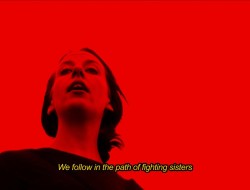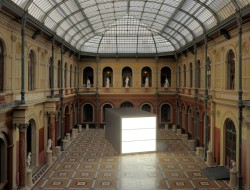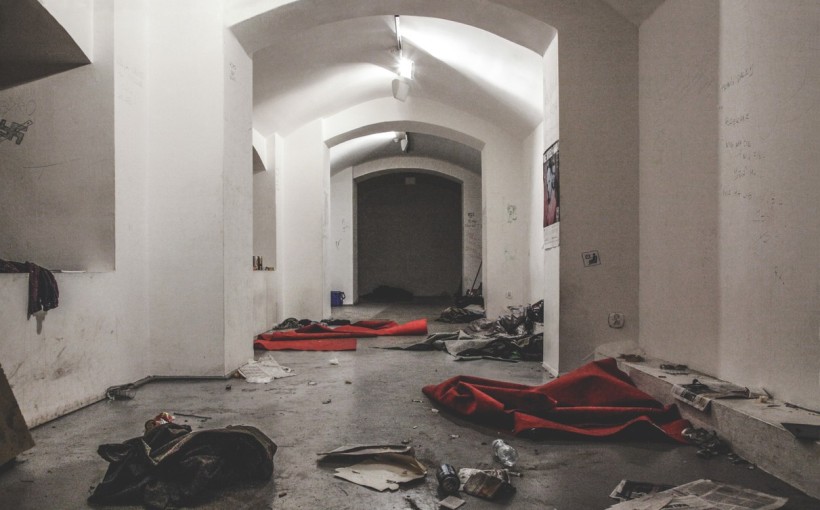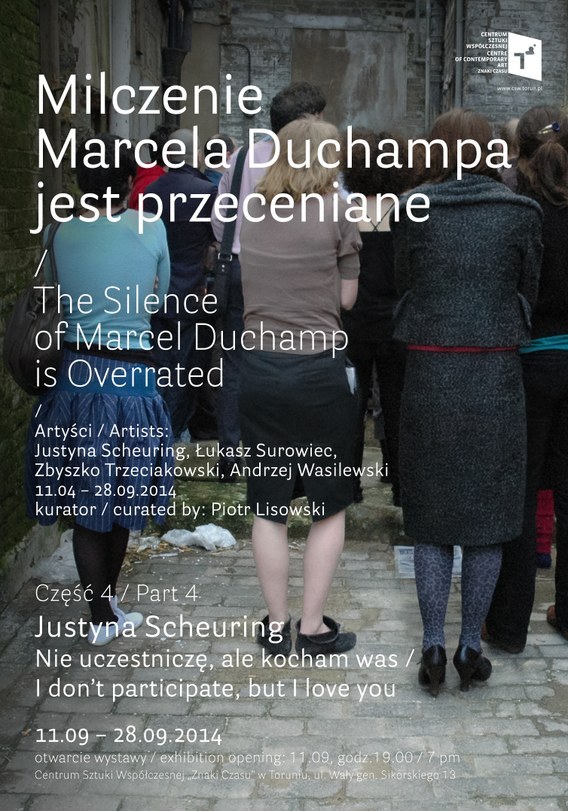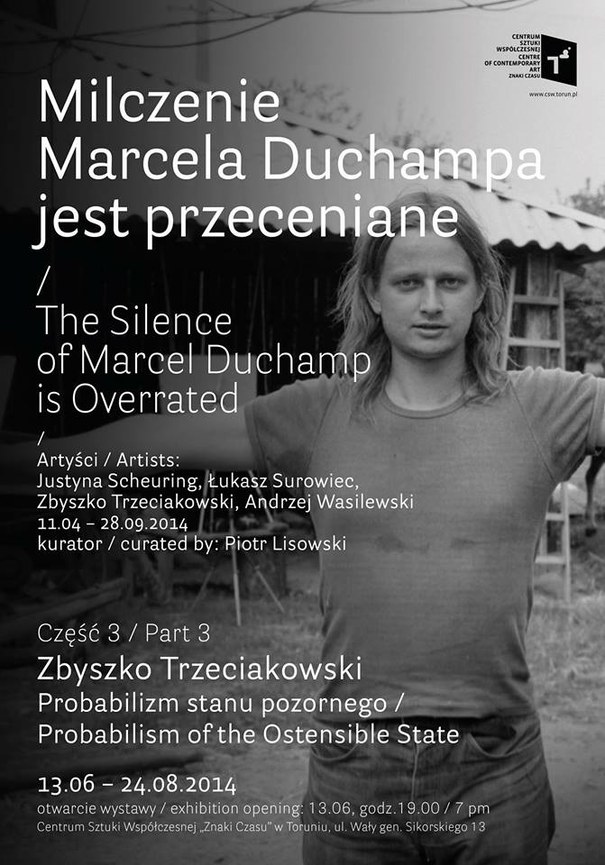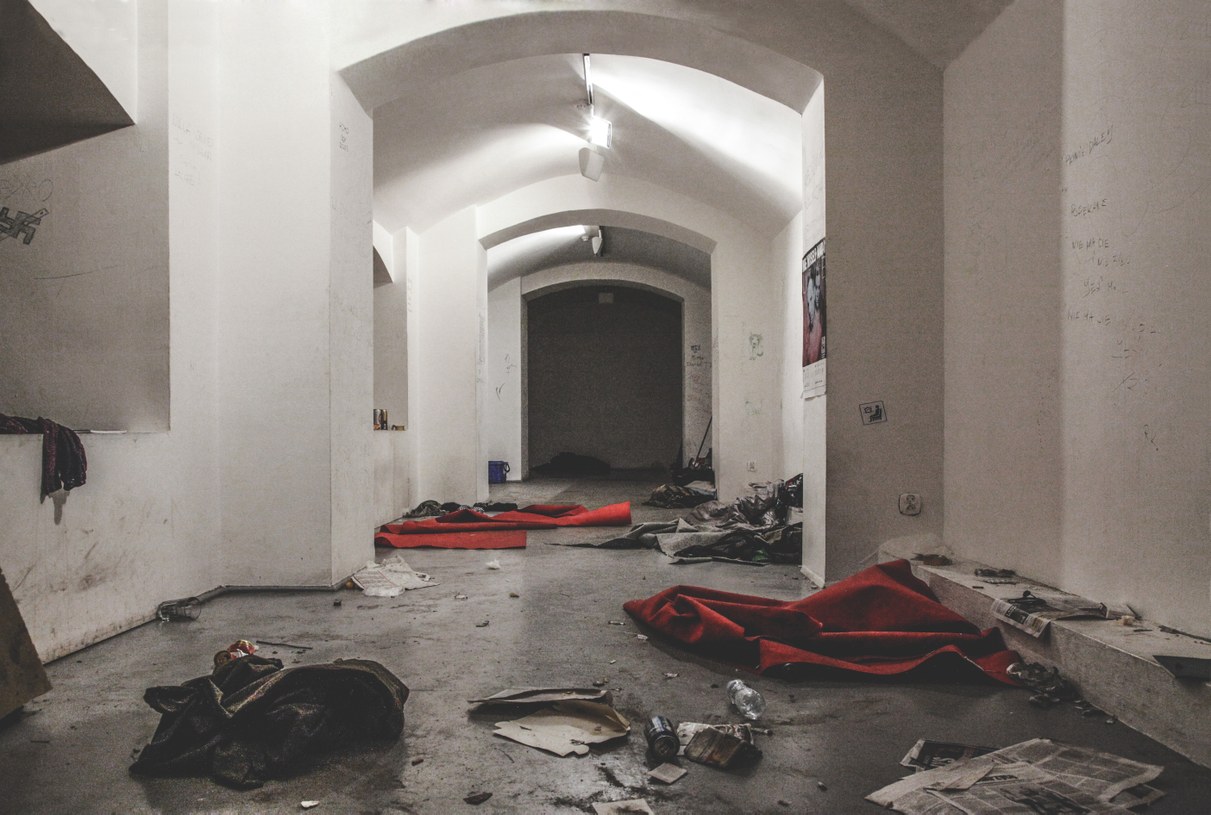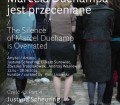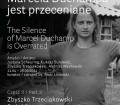artists: Justyna Scheuring, Łukasz Surowiec, Zbyszko Trzeciakowski, Andrzej Wasilewski
Center of Contemporary Art Znaki Czasu in Toruń
curator: Piotr Lisowski
Part 4: Justyna Scheuring „I don’t participate, but I love You”
11.09 – 28.09.2014
I don’t participate but I do love you – an exhibition by Justyna Scheuring is best described as a performance act and it’s a one where she is determined to capture the idea of “event” as an encounter and a presence. She expresses artistically using performance art. Her actions are to be seen as sculptures – a result of collaboration with space, objects and other people. They are works of art composed much like a musical score or a verse – with a huge respect for rhythm and timing.
During the exhibition we will see the footage from the happening arranged in the Contemporary Art Centre (CSW) in Toruń which was basically the gathering of two groups of people. This occasion was merely the foundation for what was there to happen: two different events happening simultaneously in the same space. The participants had not been informed and only realized there were two separate groups/meetings after they’ve arrived. Both occasions called for certain conventional sets of behaviour, one very different from another. The confusion and discordance resulting from the two events happening at once is just a pretext for close examination of human behaviour. The outcome is a complete unknown and so are the reactions of the participants. How to behave in a seemingly familiar but actually completely unexpected situation? Who knows how the events will unfold? Things might go undisturbed much as they were expected but there is a chance that people’s reactions would get emotional when they realize they fell victim to manipulation. All eventualities would inevitably become the part of the project, every reaction is excused by the very situation that had caused it and there is always a possibility of things going pear shaped when the performance will simply not work at all. The artist who has inspired the situation is nowhere to be seen, remaining just a stage director, so to speak. Once people step into the situation they commit themselves to participate in it. The rest is an absolute unknown, a social experiment and a mistery.
Part 3: Zbyszko Trzeciakowski „Probabilism of the Ostensible State”
13.06-24.08.2014
As we enter the area of Zbyszko Trzeciakowski’s (1957–2006) creative output, we find ourselves in a space situated between two elements. One is based on research of media, focused on mechanical recording (photography, video). The other involves intimate, extreme and destructive experiences employing the body (actions, performance). It is only at the meeting point of these two elements that form, for which presence and contact with a living person remain crucial, takes shape.
Regardless of whether the objective of the artist’s work was to experience himself, to research and record the medium or to search for new forms of contact, it was the human element – even if it was restricted to the role of coincidence – that determined a common horizon of experiencing. Reality, daily life as well as social and political circumstances were treated as a field of cognition where particular situations and events encourage one to take the effort to discover ways of affecting the world in which we are living. Regardless of its ostensible nature and the effects of such discovery.
Showing traces and fragments of the artist’s work, the exhibition accentuates this form, bringing photographic experiments and radical actions from the first half of the 1980s into focus. His connections with the Kultura Zrzuty circle also influenced his work. As a member of the movement, Trzeciakowski participated in private plein-air sessions in Teofilów (1983) and Zadzim (1982), collaborated with the Tango magazine and later co-edited his own art‑zine bez tytułu (untitled). Independent artistic circles and a specific nature of his work became an important code of the artist’s oeuvre. Until the very end, Trzeciakowski remained on the margins, refusing to make choices imposed by reality and escaping schematic thinking and acting. Withdrawal and the permanence of this state were his most radical gesture.
Part 2: Andrzej Wasilewski Les Fleurs du mal
16.05 – 08.06.2014
Andrzej Wasilewski’s Flowers of Evil constitute a visual story about contemporariness. The artist’s vision is based on the combination of technological form and the aesthetics of image. The result is a subtle game hiding the impersonality of reality that surrounds us, reduced here to constantly up-dated statistical data related to problems of human population, violence, economy or energy on a global scale. Using a specially designed computer program, the artist translates this mathematical notation into visual form. As a consequence, numbers and data which tend to create distrust assume a pulsating form, reminiscent of calyces of flowers. The motif of flowers reappears twice, in spatial kinetic installations made of artificial flowers which cast shadow upon the wall as well as colourful projections with flowery composition, forming ambiguous representations of contemporary events. The image created by the artist beguiles one with its aesthetics, colour and rhythm, at the same time revealing the danger present in messages conveyed by the media that reach us every day. It was Andrzej Wasilewski’s intention to follow in the footsteps of two French thinkers – Charles Baudelaire, from whom he has loaned the title of his work, and Jean Baudrillard, who examined the effect of the media on social and cultural reality. In his own fashion, the artist passes through reality and observes it to come to the conclusion that the media have taken complete control of the world, equipping us with codes and models we use as we become passive viewers of reality. At the same time, we come to realise that the eponymous Flowers of Evil constitute an image created first and foremost by ourselves.
Andrzej Wasilewski’s project entitled Les Fleurs du mal has been subsidised from the funds of the Minister of Culture and National Heritage.
Part 1 Łukasz Surowiec – The Waiting Room
11.04-11.05.2014
The project The Silence of Marcel Duchamp is Overrated constitutes an appendix to the exhibition Arena exploring the variety of artistic methods and cultural involvement on social and political plane in the broad sense of the phrase. Its shape and character has been determined by the theme of the exhibition inspired by Joseph Beuys’ artistic stance and particularly his practices involving reflection on the social role of the artist and art as well as establishing new relations in creating and modernizing social relationships. The title of the project has been taken from Beuys’ 1964 action, where the artist entered into a dialogue with Marcel Duchamp’s achievement, criticizing his decision to abandon artistic activities. This demand for presence, participation and responsibility is founded on faith in the creative power of every individual, muffled only by standardization of behaviour, artificial social, political and cultural limitations. Narration designed in the plan of the appendix is divided into four parts and made of individual presentations where presence and participation come down to the following: exclusion, diagnosis, manipulation, radicalism, anarchism, relation and survival. The consistency of this not necessarily linear range constitutes a form of negotiation and confrontation but also a form of obligation to everyday world whose most valuable features are mutual relations.
Łukasz Surowiec – The Waiting Room
Suspending principles of social contract may produce unpredictable results. Suspending principles of social contract with the intention to enable discussion constitutes an act bordering on perversion. For Łukasz Surowiec, interference in the real world is the only way to explore and reveal social mechanisms. An example of this method is The Waiting Room – a space established by the artist within the framework of the Dziady exhibition at the Bunkier Sztuki Gallery in Krakow (2013). Open 24/7 to everyone, it was meant to serve as a waiting room – a room for people who were waiting for something. Everybody waits for something. Everybody has desires and something to say. Waiting frequently creates opportunity to begin a relationship, converse, share experiences, ponder or be excited. That was what the waiting room was designed for, based on the assumption that all social contracts were suspended in it. It was meant to constitute performative extension of the exhibition which addressed problems of the excluded and homeless. It was an experiment whose purpose was to test how efficient the kind of art that seeks to affect social reality could be. As a consequence, under the exhibition rooms, in the basement of a public institution a waiting room was established which came to be dominated by homeless people. In less than a month, it became home, eating place, bedroom as well as a place where everyone could come to talk to its inhabitants. The prosaic experience of waiting and being together led to reflection on social structures, problems of exclusion and presence in the society as well as, unexpectedly, became an inspiration for specific deeds and dreams. The event was registered as a documentary film, a collage of images of everything that happened in The Waiting Room.
 The Institution is funded from the budget of Toruń Municipality
The Institution is funded from the budget of Toruń Municipality
